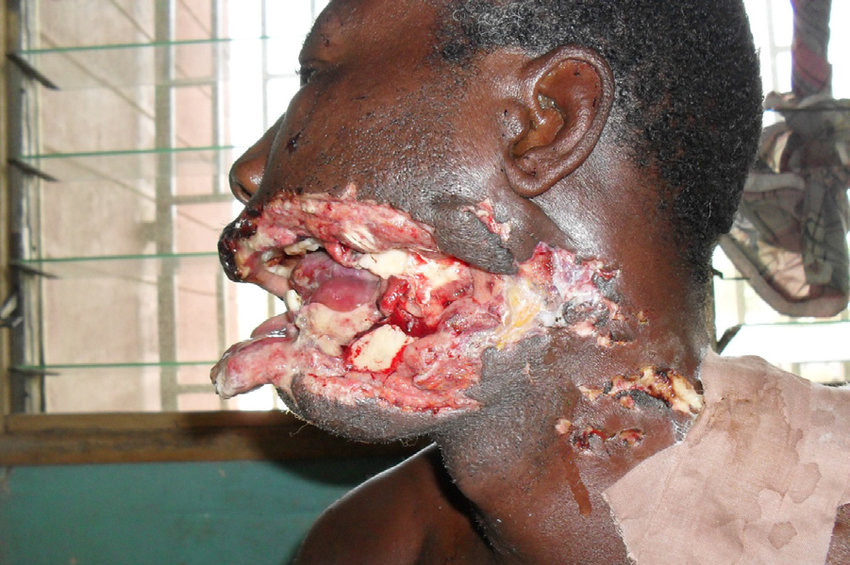
Date: 2024-12-21 Page is: DBtxt003.php txt00024402
GUN VIOLENCE
WASHINGTON POST SERIES (MARCH 2023)
Why we are showing the impact of bullets from an AR-15 on the human body:
The toll that the high-velocity rounds exact as they move through human
tissue, bones and organs is not widely understood.
WASHINGTON POST SERIES (MARCH 2023)
Why we are showing the impact of bullets from an AR-15 on the human body:
The toll that the high-velocity rounds exact as they move through human
tissue, bones and organs is not widely understood.
| HOME | BRIEFS | L020-IS-ISSUES-ALPHA | L020-IS-ISSUES-CHRONO | Last | Next txt00024402 |

Original article: https://www.washingtonpost.com/nation/2023/03/27/about-ar-15-investigation/
Peter Burgess COMMENTARY
I have added the image above. This was not part of the Washington Post article. When I went to 'Google' to find an image, the summary page was blurred to avoid disturbing people who might see the images ... but why? We tolerate gun violence and the people and companies that benefit from the production and sale of these awful lethal weapons. I am perfectly prepared to be 'in your face' when it comes to the horror of gun violence.
Peter Burgess
The toll that the high-velocity rounds exact as they move through human tissue, bones and organs is not widely understood
By Sally Buzbee
March 27, 2023 at 6:00 a.m. EDT
In The Blast Effect, The Washington Post shows the mechanics of the AR-15 and the toll its high-velocity rounds exact as they move through human tissue, bones and organs.
The catastrophic damage the bullets from AR-15s cause inside human bodies is rarely made public in detail. News organizations do not generally publish graphic autopsy or crime scene photos because the images could be viewed as dehumanizing, exploitative and traumatizing, or could inflict further pain on the families of victims. As a result, the damage AR-15 fire can do to a human body — a great deal more than handguns — is not widely understood.
When we set out to chronicle the story of the AR-15 in America, we searched for ways to illustrate that effect on bodies in an unflinching but respectful manner. We recognize that this presentation may disturb readers, but we determined the information it contains is critical to the public’s knowledge.
Two principles shaped our approach: to show the impact on a body with precision and to share our findings through visualizations that meet our ethical standards. To accomplish that, we decided it was essential to document and depict actual mortal wounds to actual victims, using animated illustrations that show the entrance and exit wounds in human figures.
As part of our reporting, we filed 13 public information requests with medical examiners and other authorities around the country to obtain autopsy reports of victims in mass killings. We then scrutinized nearly 100 autopsy reports from five mass killings to analyze patterns of deadly wounds. That analysis revealed that in four of those shootings, many victims were shot in close proximity, multiple times.
We also conducted extensive interviews with two trauma surgeons, two ballistics experts and a medical examiner about the hallmark indicators of mortal wounds from the high-velocity rounds from the AR-15. We consulted with those same experts to identify several victims whose multiple injuries are typical of the gun’s explosive power inside the body.
Among them were two homicide victims: Noah Pozner, who was killed in the 2012 Sandy Hook Elementary School shooting at age six, and Peter Wang, who was killed in the 2018 Marjory Stoneman Douglas High School shooting at age 15.
The Post identified the details specific to Peter’s death by matching details from anonymized autopsy reports from the Broward County, Fla., medical examiners’ office and the court testimony of Wendolyn Sneed, the medical examiner who performed Peter’s autopsy.
Noah’s post-mortem examination became public in 2014, when his father, Lenny Pozner, released it to try to counter lies and conspiracy theories that spread about the Sandy Hook shooting.
We decided we would not proceed with publishing the depictions of Noah’s and Peter’s wounds without the agreement of their families. Both gave their consent — in Noah’s case, through the Pozners’ attorney, and in Peter’s case, through a cousin who serves as a family representative. They declined to review the presentation before it published.
Using court testimony from medical examiners and autopsy records, a team of journalists created three-dimensional illustrations that depicted where the bullets hit Noah and Peter. We selected a monochromatic palette for the presentation and used color only to direct attention to key findings. To focus on the parts of the body that were struck in both the hypothetical scenario of a chest wound and in the models created from autopsy reports, The Post removed some anatomical references from the illustrations.
The first part of the resulting piece models a hypothetical gunshot to show the effect of a single bullet if it were to hit a person in the chest. The second part features separate illustrations that depict the actual entrance and exit wounds of Noah and Peter, based on the public records we examined.
When writing an autopsy report, a medical examiner meticulously investigates every wound and every inch of a body. We have followed that rigor in creating this account.
| . |
| HOME | BRIEFS | L020-IS-ISSUES-ALPHA | L020-IS-ISSUES-CHRONO | Last txt00024401 | Next txt00024403 |